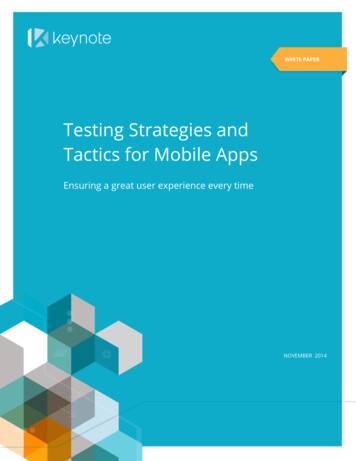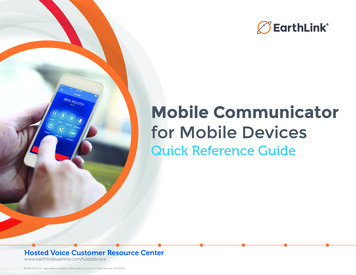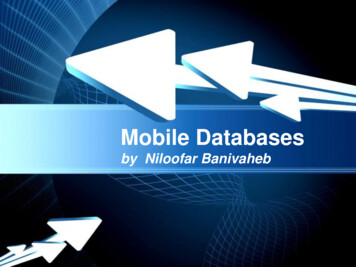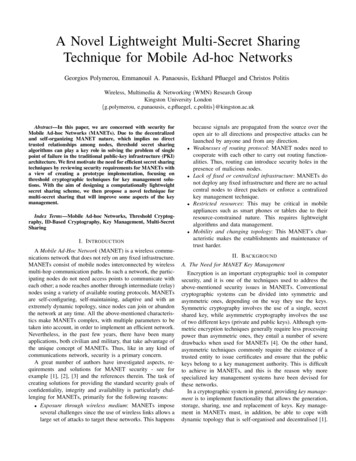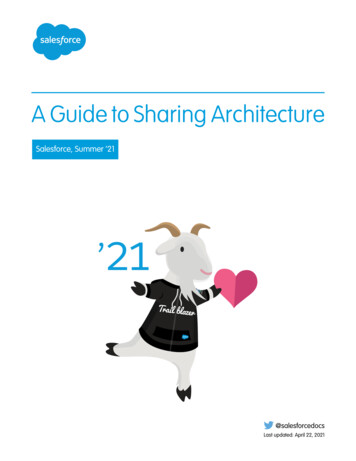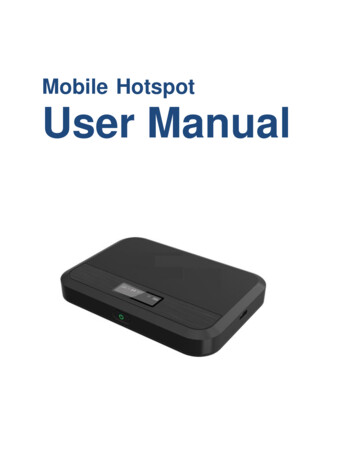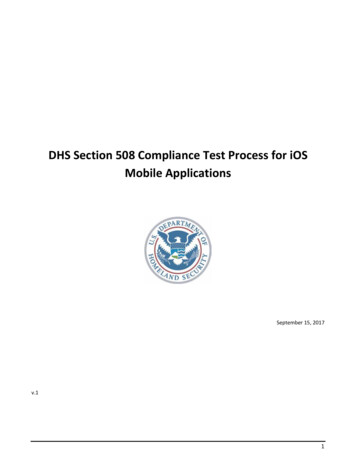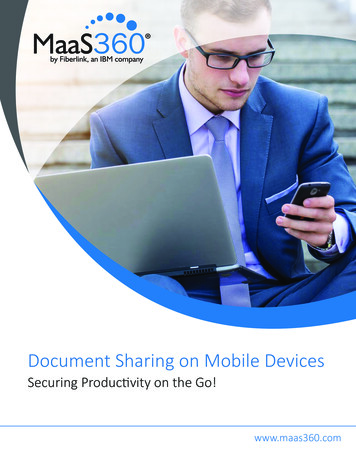
Transcription
Document Sharing on Mobile DevicesSecuring Productivity on the Go!www.maas360.com
MaaS360.com White PaperCopyright 2014 Fiberlink Communications Corporation. All rights reserved.This document contains proprietary and confidential information of Fiberlink, an IBM company. Nopart of this document may be used, disclosed, distributed, transmitted, stored in any retrieval system,copied or reproduced in any way or form, including but not limited to photocopy, photographic,magnetic, electronic or other record, without the prior written permission of Fiberlink.This document is provided for informational purposes only and the information herein is subject tochange without notice. Please report any errors to Fiberlink. Fiberlink will not provide any warrantiescovering this information and specifically disclaims any liability in connection with this document.Fiberlink, MaaS360, associated logos, and the names of the products and services of Fiberlink aretrademarks or service marks of Fiberlink and may be registered in certain jurisdictions. All other names,marks, brands, logos, and symbols may be trademarks or registered trademarks or service marks oftheir respective owners. Use of any or all of the above is subject to the specific terms and conditionsof the Agreement.Copyright 2014 Fiberlink, 1787 Sentry Parkway West, Building Eighteen, Suite 200, Blue Bell, PA 19422.All rights reserved.2
MaaS360.com White PaperDocument Sharing on Mobile Devices: Securing Productivityon the Go!Table of ContentsIntroduction: Enterprise Documents Go Mobile. . . . . . . . . . . . . . . . . . . . . . . . . . . . . . . . . . . 4Solving the Secure Data Conundrum. . . . . . . . . . . . . . . . . . . . . . . . . . . . . . . . . . . . . . . . . . . . 4Ensuring Productivity in the Field. . . . . . . . . . . . . . . . . . . . . . . . . . . . . . . . . . . . . . . . . . . . . . . 5Is This the RIght Version? . . . . . . . . . . . . . . . . . . . . . . . . . . . . . . . . . . . . . . . . . . . . . . . . . . 5Are You Compliant?. . . . . . . . . . . . . . . . . . . . . . . . . . . . . . . . . . . . . . . . . . . . . . . . . . . . . . . 5Security, Scale, Simplicity . . . . . . . . . . . . . . . . . . . . . . . . . . . . . . . . . . . . . . . . . . . . . . . . . . 6Benefits of Secure Document Sharing. . . . . . . . . . . . . . . . . . . . . . . . . . . . . . . . . . . . . . . . . . . 7Securely Enabling the Business. . . . . . . . . . . . . . . . . . . . . . . . . . . . . . . . . . . . . . . . . . . . . . 7Delivering on the Promise of BYOD . . . . . . . . . . . . . . . . . . . . . . . . . . . . . . . . . . . . . . . . . . 7MaaS360 by Fiberlink . . . . . . . . . . . . . . . . . . . . . . . . . . . . . . . . . . . . . . . . . . . . . . . . . . . . . . . . 73
MaaS360.com White PaperIntroduction: Enterprise Documents Go MobileIn this paper, weexamine thechallenges of managingcontent on mobiledevices and discussone solution for securedocument sharing.The first wave of the enterprise mobility phenomenon is already underway, as many organizationsbegin to formalize the previously non-sanctioned art and science of Bring Your Own Device (BYOD)in the workplace. The typical BYOD program secures the most basic mobile applications—email,calendar and contacts—through a combination of mobile application management (MAM) andmobile device management (MDM). Now there’s a new challenge afoot, and few tools on themarket can effectively manage the issues IT professionals are about to face: the need to securelydistribute documents to mobile devices.In this paper, we examine the challenges of managing content on mobile devices and discuss onesolution for secure document sharing.Solving the Secure Document ConundrumIf you’re in the IT department, you bear the most responsibility for the successful, secure distributionof documents. Understandably, mobile devices present the greatest fear, uncertainty, and doubt giventhe relative infancy of smartphones and tablets and their amazing computing capability.Corporate-issued laptops and BlackBerry devices could be secured, but mass-market smartphonesand tablets are designed to work on any network, not just the corporate VPN. The informationleakage risks on these devices permeate the entire enterprise. Consider the busy board memberwith next quarter’s financial projections on her iPad. What happens when these documents areaccessing unsecured Wi-Fi hotspots or the iPad is left behind in an airport? Email has been the go-tomethod for document sharing, but although familiar, it isn’t secure. Once emailed, documents can’tbe recalled and the Forward button is just a click away.Consumer file-sharing and synchronization applications such as Dropbox, Box.net, and iCloudare catching on with business users because they are accessible and convenient. But that ease ofaccessibility is the crux of the problem. You can’t tell what’s happening to documents on file-sharingsystems, and there’s no taking them back. You also can’t change document sensitivities or establishworkflows for read/write access. These applications lack security controls and centralized administration,putting enterprises at risk for data leaks, security attacks, and regulatory compliance violations.The rise of video as a sales tool presents another conundrum. Many email programs limit attachmentsto 10MB, but videos are often larger than 100MB. They can be stored centrally on a streaming server,but charges start every time someone starts streaming, and network access is mandatory. In today’s“always-on” economy, no company can afford a failed presentation due to connectivity loss.4
MaaS360.com White PaperEnsuring Productivity in the FieldWith the right system,the latest documentscan be pushed directlyto devices, rather thantraversing through emailor complex networkfolders.As the main users of mobile documents, most likely on their own personal devices, business userswant to be productive in the field. They need a reliable way to get presentations and sales collateraldelivered to their phones and tablets.Is this the Right Version?Marketing moves at a blistering pace, perpetually updating materials to reflect the latest competitivedifferentiators—yesterday’s materials could be more detrimental than no material at all. Businessusers need to be sure they have the latest versions, and they don’t want to have to hunt throughemail to find them.With the right system, the latest documents can be pushed directly to devices, rather thantraversing through email or complex network folders. Changes to the price list, sales materials, orother corporate collateral can be pushed out immediately so that everyone gets the most up-todate information at once.Are You Compliant?Depending on your industry, you may have additional constraints on the type of data you cantransmit without encryption. Publicly traded companies are subject to Sarbanes-Oxley Act (SOX)legislation, which restricts distribution of financial information outside of controlled financialreporting periods, for example. Can your iPad currently support this era of hyper-regulation?In financial services, FINRA (Financial Industry Regulatory Authority) requires that smartphonesand tablets be in compliance with a firm’s broader privileged information requirements forprotecting consumer information. Sadly, there is no out-of-the-box app for that.HIPAA, the Health Insurance Portability and Accountability Act, provides similar consternationfor the medical industry, with rules prohibiting the storage of unencrypted personally identifiableinformation and protected health information.5
MaaS360.com White PaperRequirements for Secure Document SharingGiven the concerns of IT and business around content on mobile devices, a set of requirementsis emerging: A secure and intuitive workspace for storing, syncing, and sharing corporate files onmobile platforms, completely separated from personal data. Centralized administrative controls so that IT can have full visibility into document accessand rule-based restrictions. Seamless integration with existing authentication and authorization systems. Remote, secure dissemination of files, with robust workflows for mass or selectivedistribution. Blacklisting certain file sharing and synchronization applications on mobile devices toblock their use for specific users, groups, or the entire population. User restrictions on moving emails between accounts, and on personal apps from sendingemails, to eliminate the risk of corporate data leakage. Remote wipes for out-of-date information, lost devices, employee exits, or out-ofcompliance devices that have been “jail-broken” or “rooted.”Security, Scale, SimplicityManaging documents on mobile devices is multidimensional. You need security. You need scale tomeet the needs of myriad users. And somehow, you need to keep all this simple. Here’s a look at thethree S’s of document sharing.Security. A secure container on the mobile device is paramount for protecting sensitive data at rest and inuse. Users can’t copy documents from the container or email them to others. Location-based policiescan be set using the device’s GPS to lock sensitive documents in compromised or unsecure locales.Scale. A global, managed cloud solution is the only answer for scalable distribution. You can storedocs once and distribute often, without worrying about storage capacity or bandwidth constraints.This is critical, as video and multimedia presentations become the norm for effective sales.Simplicity. End users have a simple, searchable document management app that makes it easy tofind and open files. Business executives can see who downloaded or saved a particular document.IT managers easily configure network security settings, access rights, and device support.6
MaaS360.com White PaperBenefits of Secure Document SharingProductivity increasesbecause users have theability to receive andconsume corporatecontent anywhere andanytime, outside of thetypical scope of email,including videosand ebooks.Both IT and business can reap rewards from document sharing for mobile devices.Securely Enabling the BusinessUsers want to use their own devices to work on documents. Even if IT says “no,” today’s users aresavvy and will find a way around that. Through the cloud, IT is empowered to say “yes” to mobilerequests, with the assurance that security and version control will never be compromised. In addition,a cloud-based solution dramatically cuts deployment and maintenance costs. All this means thatIT can start using its specialized skills for higher-value enterprise initiatives—instead of tending toanother server.IT can securely enable the business through role-based access and administrative managementfrom a centralized console and rest easy that documents can’t be opened anywhere besides asecure container on a user’s phone. Critically, when a sandbox is integrated with MDM functions, ITcan establish a correlation between documents and the state of the device, giving IT the flexibilityto write role-based or broad-stroke risk management policies.Delivering on the Promise of BYODThe promise of BYOD is fulfilled through secure document distribution. Users can work on thedocuments they need on the device of their choice. Sales and marketing staff and board memberscan rest assured they have the latest, approved version of documents when they go into meetings.Productivity increases because users have the ability to receive and consume corporate contentanywhere and anytime, outside of the typical scope of email, including videos and ebooks. File sizesare manageable and don’t cause delays or system hiccups. Users can enter data in the field and knowtheir colleagues will get updates immediately.A simple document catalog helps pinpoint the version of the file you need, providing a streamlined process,designed specifically for the mobile experience. And with location- and context-based policies in place, IT cancontrol where sensitive documents are accessed. Losing a personal device with corporate data onboardno longer has to be a massive emergency or a career-ending error. Conflict with IT over personaldevice use is greatly reduced.MaaS360 by FiberlinkMaaS360 by Fiberlink, an IBM company provides a secure, web-based console to centrally managedocuments, users, access controls, distribution, and policies. Each document can have its own securitysettings and be distributed to all users, groups, or individual devices, creating a highly personalizedand compliant document catalog for each employee. Workgroup-oriented roles enable marketing,sales, operations, and finance departments to use MaaS360’s secure mobile document sharingcapabilities with optimized reporting and workflows.All brands and their products, featured or referred to withinthis document, are trademarks or registered trademarks oftheir respective holders and should be noted as such.For More InformationTo learn more about our technology and services visit www.maaS360.com.1787 Sentry Parkway West, Building 18, Suite 200 Blue Bell, PA 19422Phone 215.664.1600 Fax 215.664.1601 sales@fiberlink.comWP 201203 00347
MaaS360 by Fiberlink. MaaS360 by Fiberlink, an IBM company provides a secure, web-based console to centrally manage documents, users, access controls, distribution, and policies. Each document can have its own security . settings and be distributed to all users, groups, or individual devices, creating a highly personalized

